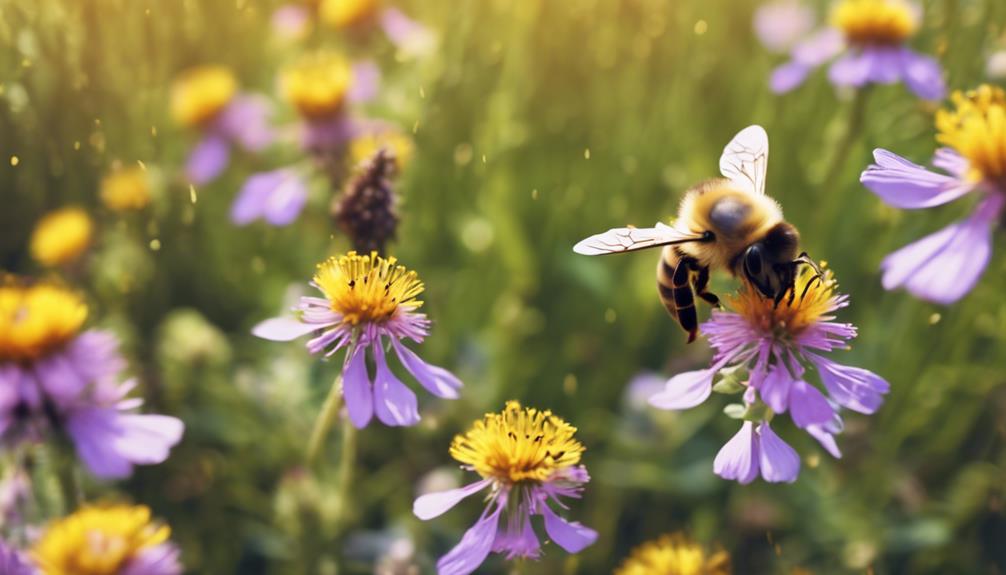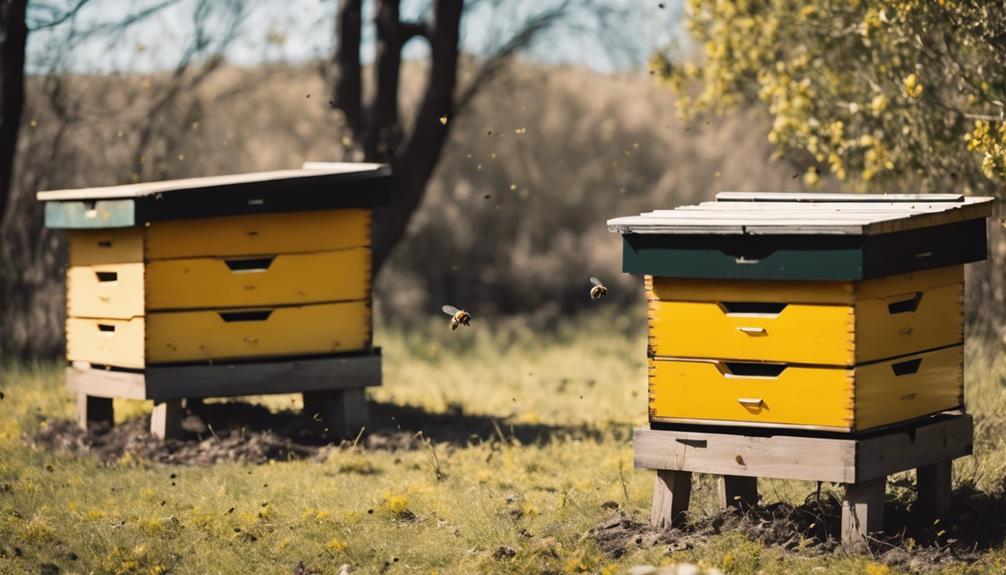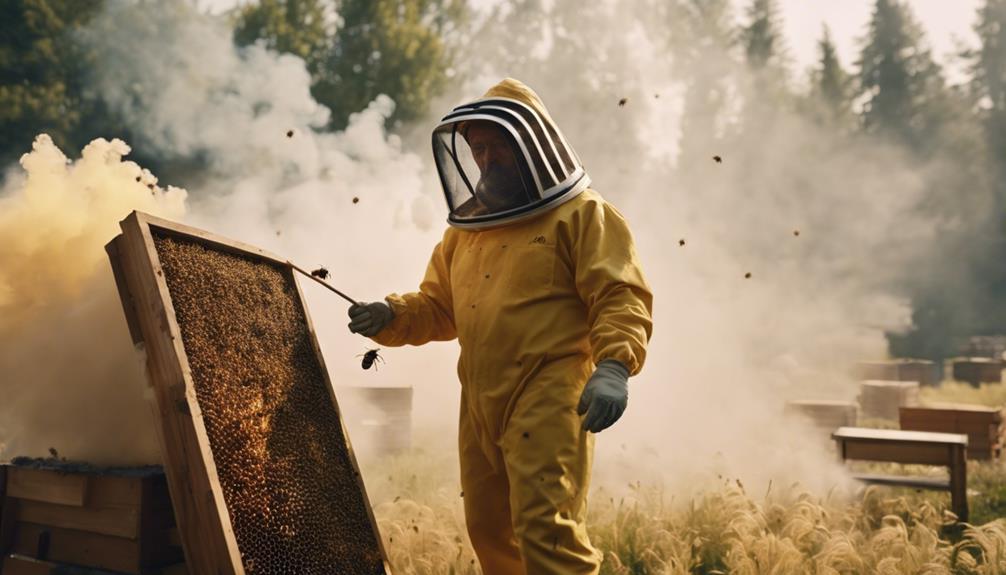Worker bees are the powerhouse of a hive, taking on various roles vital for its survival. Starting as nurtured larvae, we mature into house bees, caring for the young before shifting to field bees, braving the outdoors for nectar and pollen. Our genetics keep us females without reproductive capability, ensuring hive survival. Equipped with specialized body parts, we tackle hive maintenance, showcasing selfless dedication. Our gut bacteria composition influences our tasks, shaping hive efficiency. Curious about more ways we keep the hive thriving? Stay tuned for a deeper look into the fascinating world of worker bees.
Main Points
- Worker bees are female, infertile, and responsible for hive tasks.
- They progress from nurturing young to foraging for food.
- Worker bee tasks evolve for hive efficiency and productivity.
- Specialized roles in hive maintenance and productivity optimize operations.
- Gut bacteria diversity influences worker bee health and behavior.
Worker Bee Life Cycle
During their brief but essential lifespan, worker bees undergo a carefully orchestrated life cycle, seamlessly evolving through various roles within the hive. Worker bee larvae are nurtured with royal jelly and a special diet, maturing into adult bees in about 21 days.
As worker bees emerge, they start as house bees, tending to the hive and caring for the young. Eventually, they transition into field bees, venturing outside to forage for nectar and pollen. This progression of roles within the hive is critical for its overall functioning.
Surprisingly, in the absence of a queen, worker bees can even develop reproductive organs to lay emergency queen eggs, showcasing the adaptability and resilience of these fascinating creatures. Every worker bee plays an essential part in the hive’s success, with the queen bee reigning over this harmonious society.
Progression of Worker Tasks
As worker bees mature, they transition through a series of specialized tasks within the hive. Starting from cleaning and caretaking duties, they gradually progress to more complex roles like building cells and foraging.
This natural evolution of responsibilities guarantees that the colony operates smoothly and efficiently.
Task Specialization Evolution
In the intricate organization of a bee hive, worker bee task specialization evolves progressively from cleaning brood cells to more complex duties like feeding larvae, caring for the queen, constructing cells, and foraging for essential resources. This evolution showcases the incredible division of labor within the hive, where each worker bee plays a crucial role in maintaining hive efficiency.
As worker bees mature, they transition seamlessly between tasks, ensuring that all aspects of hive life are tended to with precision. Understanding this evolution is key to appreciating the inner workings of a hive and how each bee contributes to its overall success.
The specialized roles of worker bees not only optimize hive productivity but also sustain the delicate balance of the hive ecosystem, highlighting the beauty of nature’s meticulous design.
Lifespan Contribution Diversity
Worker bees progress through a varied range of tasks, each contributing distinctly to the hive’s functionality and survival.
- Starting as eggs and being nurtured by nurse bees, they transition into adult bees around day 21, ready to take on their responsibilities.
- Their journey begins with cleaning brood cells and feeding larvae, ensuring the next generation’s growth and health.
- As they mature, worker bees shift towards foraging for essential resources necessary for the hive’s sustenance.
- Caring for the queen becomes an important duty, maintaining harmony and stability within the colony.
- The diverse roles undertaken by worker bees not only improve hive efficiency but also play a fundamental role in securing the colony’s survival, highlighting their adaptability and significance in maintaining hive functionality.
Worker Bee Activities in Hive
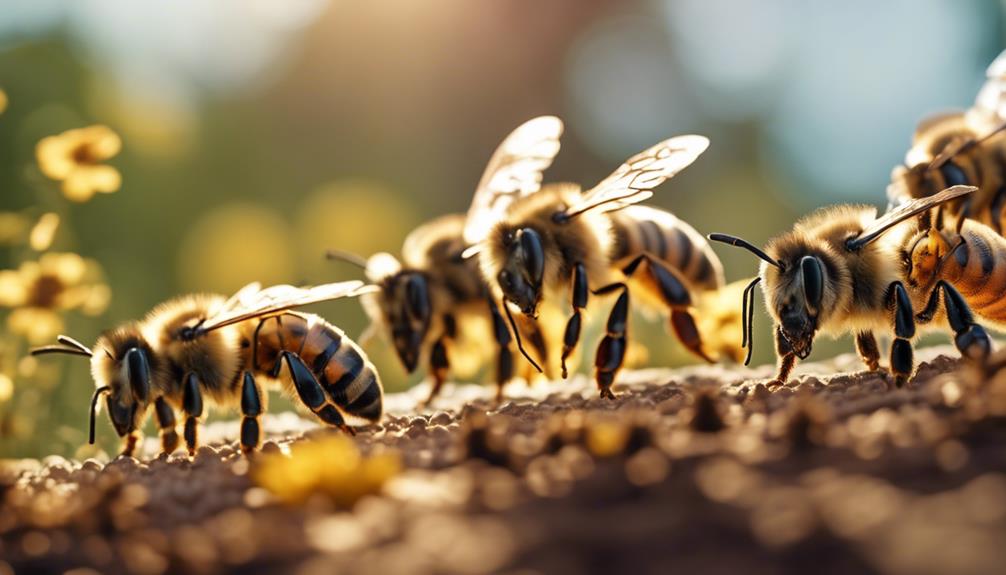
As worker bees hum around the hive, they undertake a plethora of essential tasks to keep the colony thriving.
From meticulously tidying brood cells to constructing elaborate honeycomb structures, these busy bees play a crucial role in maintaining hive order.
Their diverse roles as nurse bees, foragers, and housekeepers guarantee the smooth operation of the bustling hive community.
Hive Worker Roles
Playing an essential role in hive maintenance and productivity, worker bees in a hive are actively engaged in various tasks essential for the colony’s well-being.
- Worker bees clean brood cells, feed larvae, build honeycomb, pack pollen, and use propolis for hive maintenance.
- They seal mature honey, feed drones, and forage for resources to sustain the hive.
- These bees play a critical role in maintaining hive temperature, generating body heat, and ensuring overall hive functionality.
- Equipped with specialized body parts for nectar collection, wax production, and defending the hive against intruders.
- Worker bees exhibit a division of labor within the hive, shifting through various tasks to support the colony’s well-being and productivity.
Worker Bee Tasks
Engaged in a myriad of essential tasks within the hive, worker bees diligently carry out their duties to guarantee the colony’s survival and productivity. From cleaning brood cells to feeding larvae, building honeycomb, packing pollen, and using propolis for hive maintenance, worker bees are the backbone of hive operations.
Their resource management skills are impeccable, with roles ranging from collecting nectar to maintaining the hive’s structure. Each bee plays a crucial part in the division of labor, ensuring that the hive functions efficiently.
Whether it’s sealing mature honey, feeding drones, or engaging in various housekeeping activities, worker bees work tirelessly to keep the colony thriving. Their dedication to caring for the queen and ensuring overall well-being showcases their commitment to the success of the hive.
Genetic Characteristics of Worker Bees
Worker bees, being genetically female and anatomically lacking reproductive capabilities, play essential roles within the colony based on their specialized genetic makeup. These amazing creatures serve altruistically, driven by kin selection and infertility, ensuring the hive’s survival and functionality. Their genetic predisposition guides them into specialized roles like foraging, nursing, and hive maintenance, highlighting their selfless dedication to the colony. The unique genetic characteristics of worker bees enable them to prioritize the hive’s needs over their own reproductive motivations, showcasing their importance in the intricate web of the hive’s functioning.
- Worker bees are genetically female and anatomically lack reproductive capabilities.
- Infertility among worker bees is a result of kin selection, ensuring hive survival.
- Genetic makeup determines specialized roles like foraging, nursing, and hive maintenance.
- Selfless dedication to the colony is driven by genetic predisposition.
- Worker bees prioritize the hive’s needs over personal reproductive motivations.
Worker Bee Gut Bacteria
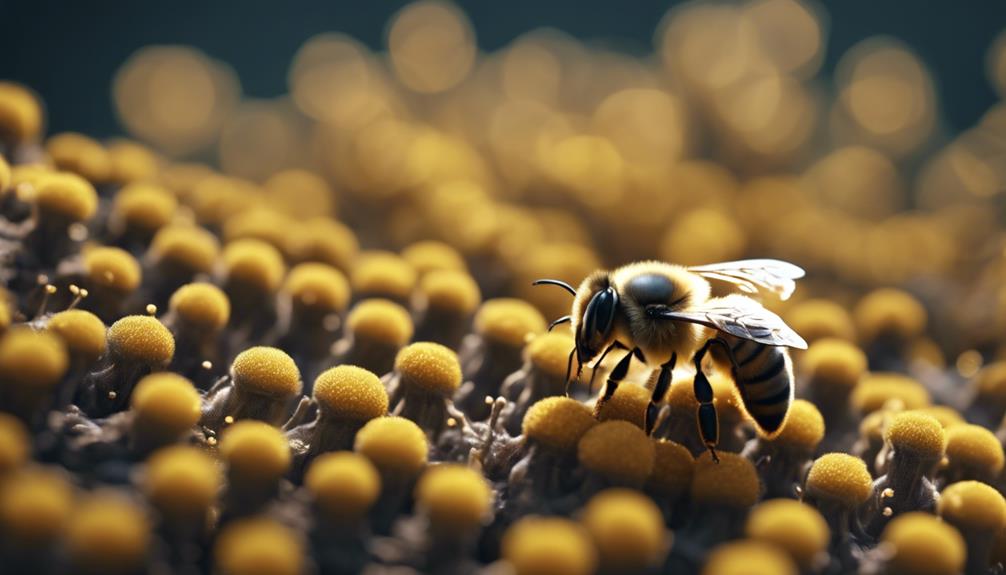
In the intricate workings of a hive, the composition of gut bacteria in worker bees is intricately linked to their tasks and responsibilities. Environmental factors play a significant role in shaping the diversity and abundance of gut bacteria in these essential insects.
The health and behavior of worker bees are heavily influenced by their gut microbiome, impacting how they perform various tasks within the hive. The landscape and floral resources available to worker bees also affect the variety of gut bacteria present in their systems.
Understanding the relationship between worker bees and their gut bacteria provides insights into how these tiny organisms contribute to the overall functioning and efficiency of the hive.
Worker Bee Stinger and Social Behavior
The essential stinger of a worker bee is a crucial tool for defending the hive and exemplifying exceptional social behavior. Worker bees possess a barbed stinger designed as a defense mechanism to protect the hive.
When a threat arises, these bees don’t hesitate to sacrifice themselves for hive protection, showcasing remarkable social behavior. Their unique behaviors set them apart from drones and queens, as they primarily focus on hive maintenance and defense.
Witnessing a worker bee in action is a true proof of the selfless nature of these tiny creatures, highlighting their unwavering dedication to the collective well-being of the colony.

Hello! My name is Noel Calvin. I graduated from UCLA and now work as a writer at Launch Ninjas. I write blog posts that inspire and guide our readers in their entrepreneurial pursuits. I live in Pleasantville, NJ, with a peaceful yet lively atmosphere that inspires me.
Writing stories is more than just a job for me. It allows me to share my observations and satisfy my curiosity about the world. I combine my analytical skills with creative enthusiasm to delve into technology trends and startup stories. But my life isn’t limited to screens and keyboards. I value loyalty, passion, and a touch of old-fashioned charm, which I infuse into every narrative I create.
I love spending time in my garage, jamming with my band when I’m not writing. Playing the guitar and singing bring me immense joy. I also enjoy capturing ordinary and extraordinary moments through my camera lens and exploring new culinary adventures that excite my taste buds. I’m always seeking new experiences.
My family is very important to me. Joyful Sunday brunches filled with laughter and intense board game nights keep me grounded, reminding me of life’s simple pleasures.
In my world, every moment is an opportunity for discovery. Every discovery is a story worth sharing, whether a heartfelt moment at home or the pulse of technological innovations. Join me as I navigate through life, one blog post, one guitar strum, and one heartwarming family dinner at a time.
